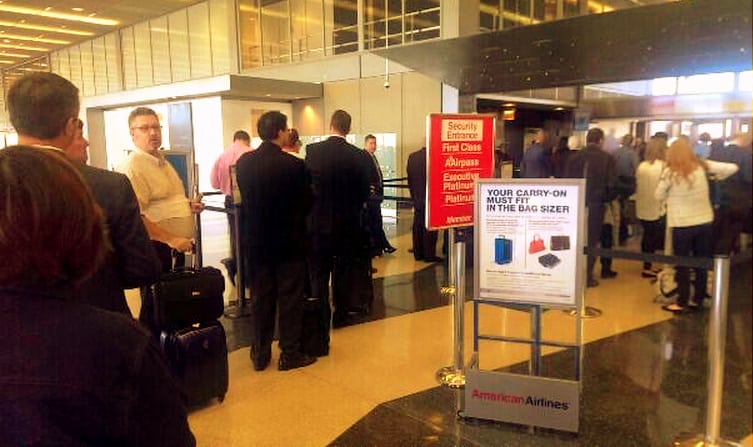Skift Take
TSA Precheck may end up being more of a hindrance than a solution to overcrowded security lines, especially at peak times at major gateway airports.
Weaving through the tunnels and baggage claim of O’Hare’s Terminal 1 last week, I climbed the stairs to the ticketing level of the airport and stopped dead in my tracks before a line of sullen passengers.
“Is this the PreCheck line?” I asked, wildly looking around the terminal.
The other passengers grunted in assent and looked back down at their mobile phones.
A woman in a commanding yellow dress came skidding up behind me like a stock car driver pulling into a pit stop, latte in hand and with a weathered rollaboard in tow.
“Where’s PreCheck?” she scowled at us.
This isn’t an uncommon scene at airports across the country, as road-weary passengers race to sign up for the program that can help speed them through airport security. Membership allows passengers access to faster security lines where they need not remove shoes, jackets or belts and where laptops can remain in carryon bags.
Introduced in the fall of 2011, the program was initially released to only the most frequent of flyers and those enrolled in advanced screening programs such as Global Entry and NEXUS. As the program gained traction, a wider spectrum of passengers was given access.
That volume now is apparent in lines across the country, many of which have swollen with passengers eager to shave a few minutes off their transit. In many cases, the lines and the subsequent wait times are far longer than alternative means to pass through security.
“I love it,” John DiScala, frequent traveler and founder of johnnyjet.com, tells me. “But the secret is out and lines are getting longer than regular security.”
“Indeed, the PreCheck program has grown dramatically since its inception. David Castelveter, the Director of External Communications for the TSA points out that September’s enrollment was near 15 million passengers, and only one month later there are currently over 17 million participants.”
To manage the growth, the agency is taking measures to expand the volume of checkpoints geared for Precheck across the country. By year’s end, 100 airports will have updated lines, up from the 40 in place earlier this year, and in addition, many current airports will get expanded service. In Washington DC’s Dulles, where last Thursday’s line was looped serpentine around the terminal, the agency plans on opening up two more lines to help manage the load.
According to Mr. Castelveter, there will be 350 airports with PreCheck service, many of them with multiple lines, by early 2014.
That growth may not come soon enough for many of the passengers frustrated with PreCheck, as more encounter long lines at the airport and are forced to adjust their travel plans.
“These days, I have to play a guessing game of which line to take” Nick Farina, a technology entrepreneur and frequent flyer tells me. “What used to be a clean, crisp approach to security is now a jumbled mess.”
Related Read: Maybe We Should Think About Defunding the TSA After All
Another crazy precheck line at O'Hare. Secret is out. pic.twitter.com/ZPLVcdYwEU
— Grant Martin (@grantkmartin) September 26, 2013
Another day, another ridiculous line at O'Hare's T1 Pre Check. pic.twitter.com/K1BBo4T28v
— Grant Martin (@grantkmartin) October 17, 2013
Wow! The #TSA PreCheck line at #LAX's T5 (@Delta) is much linger than the regular security line. pic.twitter.com/aPLE2024v6
— JohnnyJet (@JohnnyJet) October 20, 2013
The Daily Newsletter
Our daily coverage of the global travel industry. Written by editors and analysts from across Skift’s brands.
Have a confidential tip for Skift? Get in touch
Photo credit: Long Precheck lines at Chicago's O'Hare. Grant Martin / Skift
